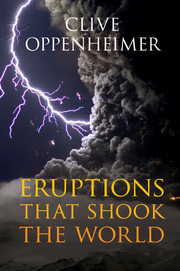Book contents
- Frontmatter
- Contents
- Preface
- Acknowledgements
- 1 Fire and brimstone: how volcanoes work
- 2 Eruption styles, hazards and ecosystem impacts
- 3 Volcanoes and global climate change
- 4 Forensic volcanology
- 5 Relics, myths and chronicles
- 6 Killer plumes
- 7 Human origins
- 8 The ash giant/sulphur dwarf
- 9 European volcanism in prehistory
- 10 The rise of Teotihuacán
- 11 Dark Ages: dark nature?
- 12 The haze famine
- 13 The last great subsistence crisis in the Western world
- 14 Volcanic catastrophe risk
- Appendix A Large eruptions
- Appendix B Further reading and data sources
- References
- Index
2 - Eruption styles, hazards and ecosystem impacts
Published online by Cambridge University Press: 01 June 2011
- Frontmatter
- Contents
- Preface
- Acknowledgements
- 1 Fire and brimstone: how volcanoes work
- 2 Eruption styles, hazards and ecosystem impacts
- 3 Volcanoes and global climate change
- 4 Forensic volcanology
- 5 Relics, myths and chronicles
- 6 Killer plumes
- 7 Human origins
- 8 The ash giant/sulphur dwarf
- 9 European volcanism in prehistory
- 10 The rise of Teotihuacán
- 11 Dark Ages: dark nature?
- 12 The haze famine
- 13 The last great subsistence crisis in the Western world
- 14 Volcanic catastrophe risk
- Appendix A Large eruptions
- Appendix B Further reading and data sources
- References
- Index
Summary
And the streams thereof shall be turned into pitch, and the dust thereof into brimstone, and the land thereof shall become burning pitch. It shall not be quenched night nor day; the smoke thereof shall go up for ever: from generation to generation it shall lie waste; none shall pass through it for ever and ever.
Isaiah 34:8–10One of the major complications of managing the risks posed by volcanoes arises from the variety of weapons in a volcano's armoury. Volcanoes can unleash ash and toxic gas clouds, lava flows and the exceptionally destructive, searing avalanches known as pyroclastic currents. Even after decades or more of lying dormant, volcanoes may emit harmful gases and particles, and, on account of their construction from inter-layered rocks and propensity towards steep slopes, can continue to pose a threat in the guise of mudflows, gigantic landslides, and tsunamis. The intensity and magnitude of eruptions only correlate in a loose sense with human impacts, since the exposure and vulnerability of societies vary greatly from one place to another.
According to a review of available records, nearly five hundred volcanic events in the twentieth century impacted people, with up to six million people evacuated or left homeless [6]. Fatalities occurred in around half of the events, with an estimated total death toll of up to 100,000. The risk of catastrophic human and economic losses from future eruptions is significant, especially given the barely restrained urban growth that has taken place in many volcanic regions.
- Type
- Chapter
- Information
- Eruptions that Shook the World , pp. 22 - 52Publisher: Cambridge University PressPrint publication year: 2011



